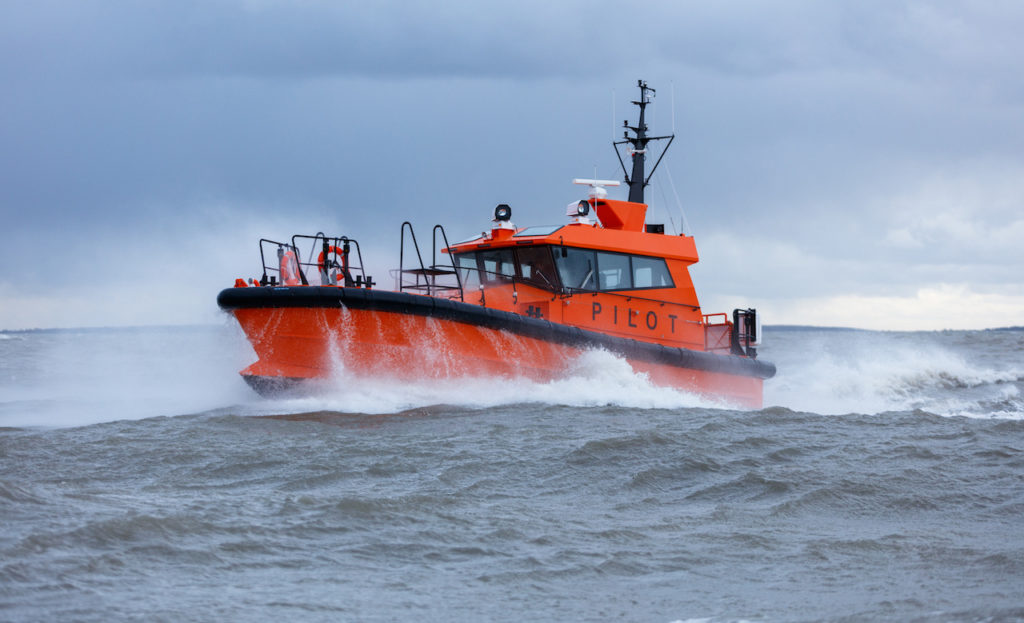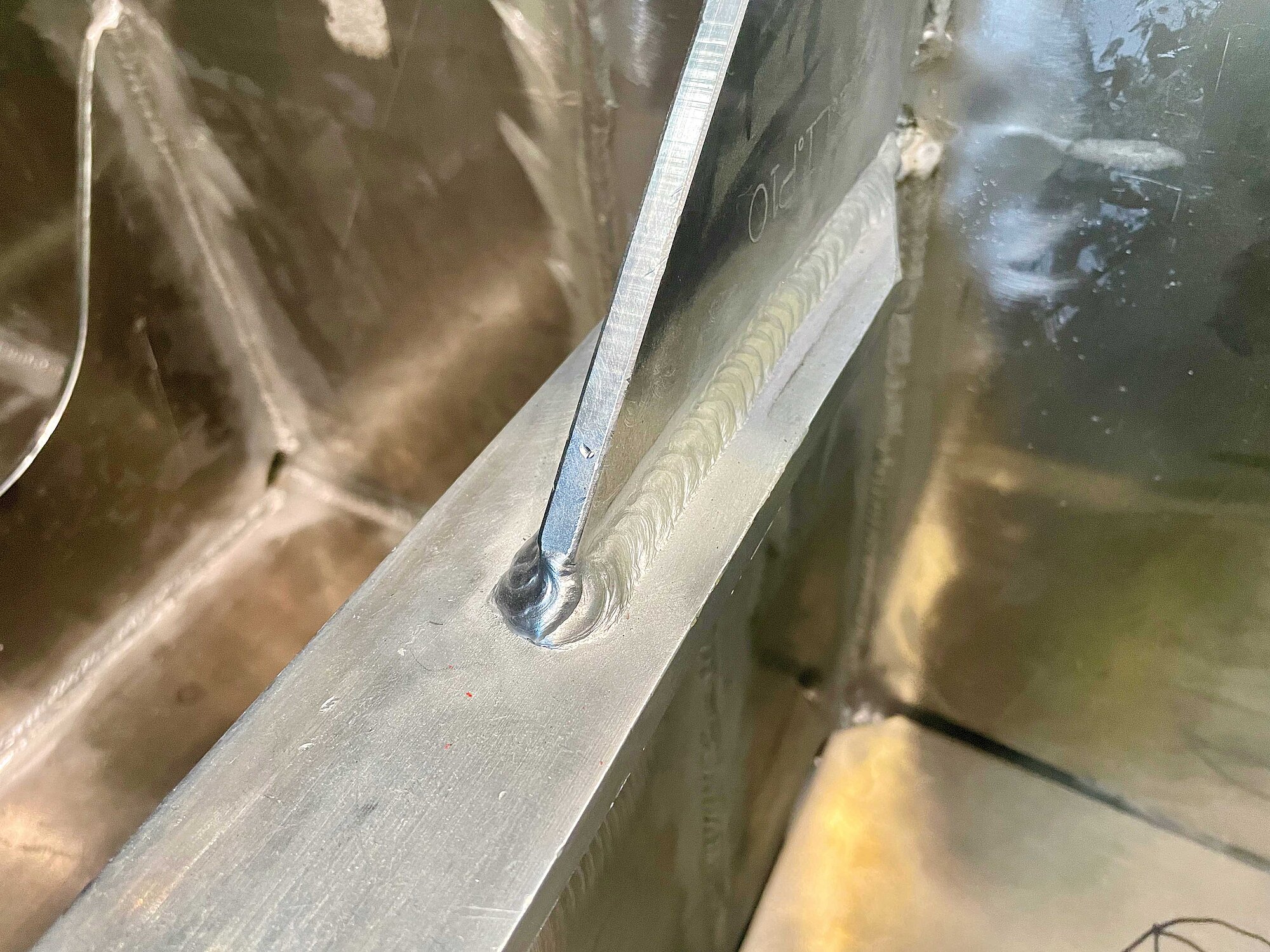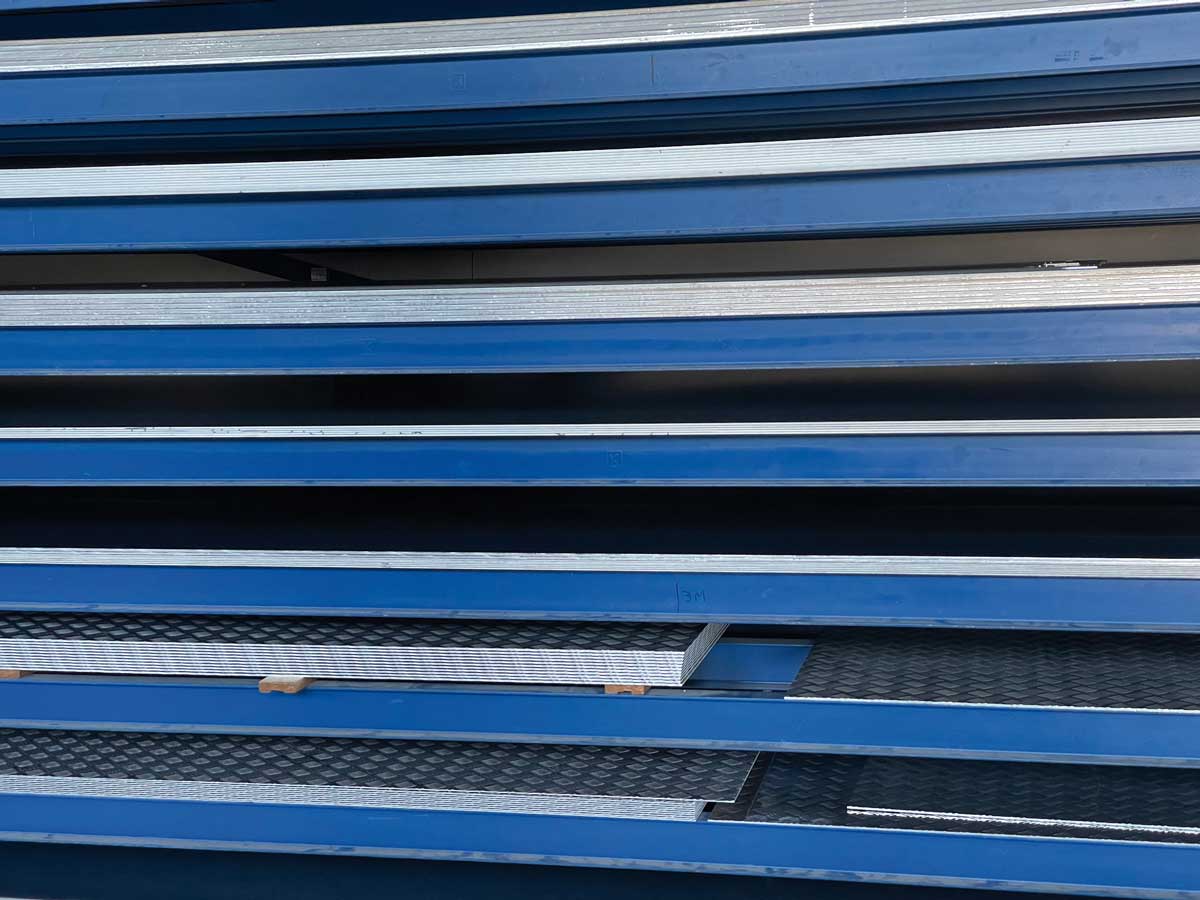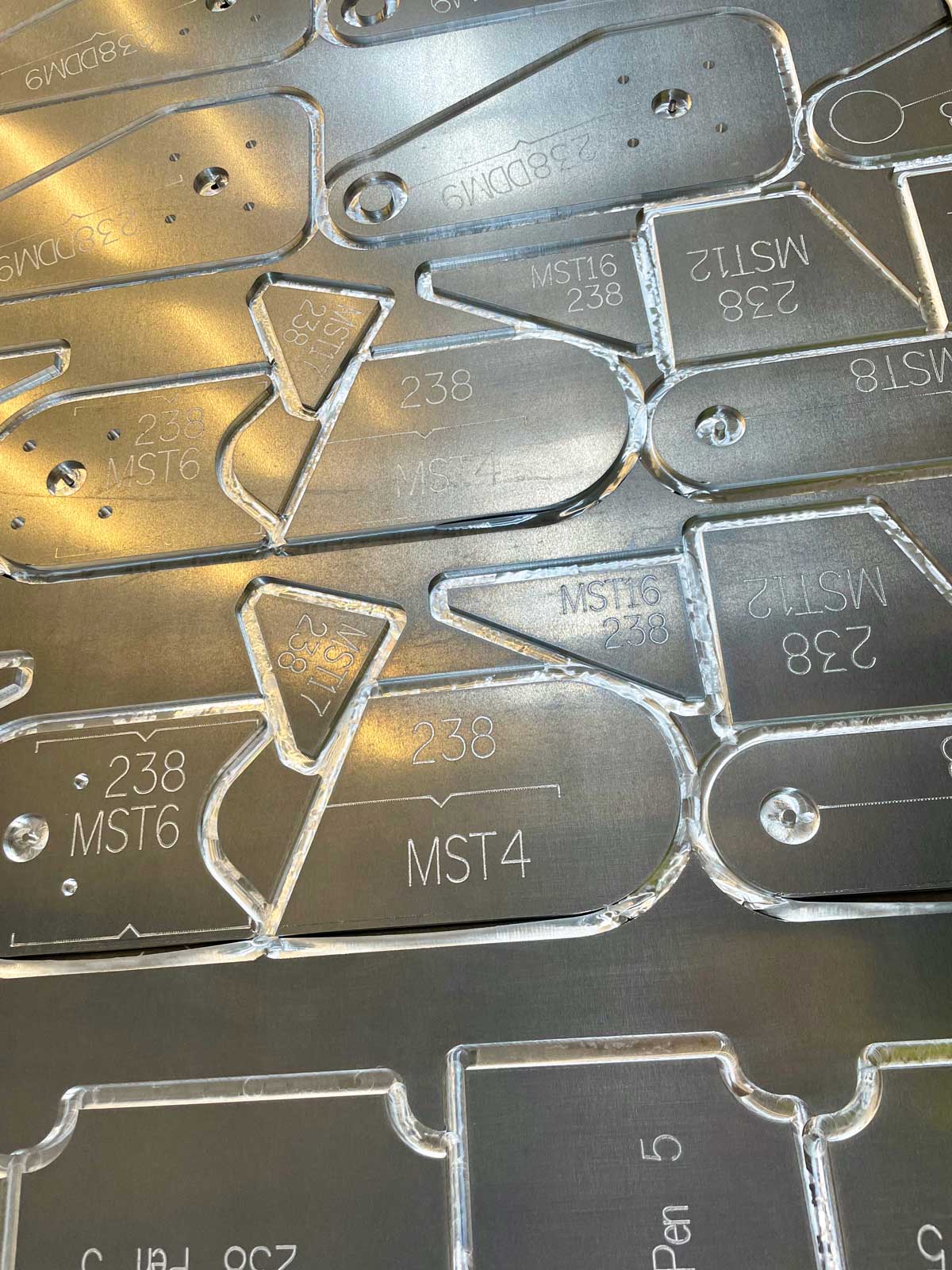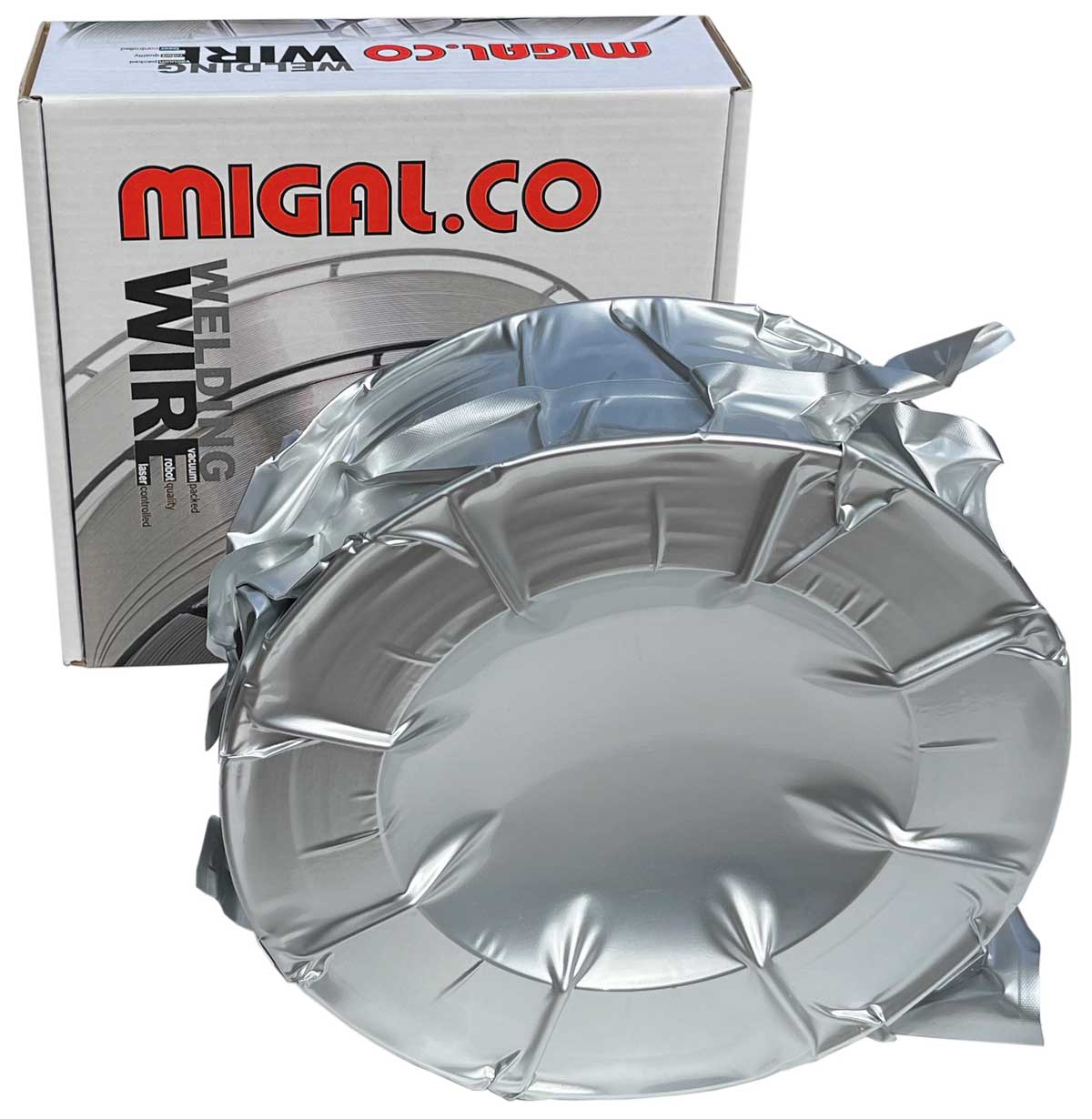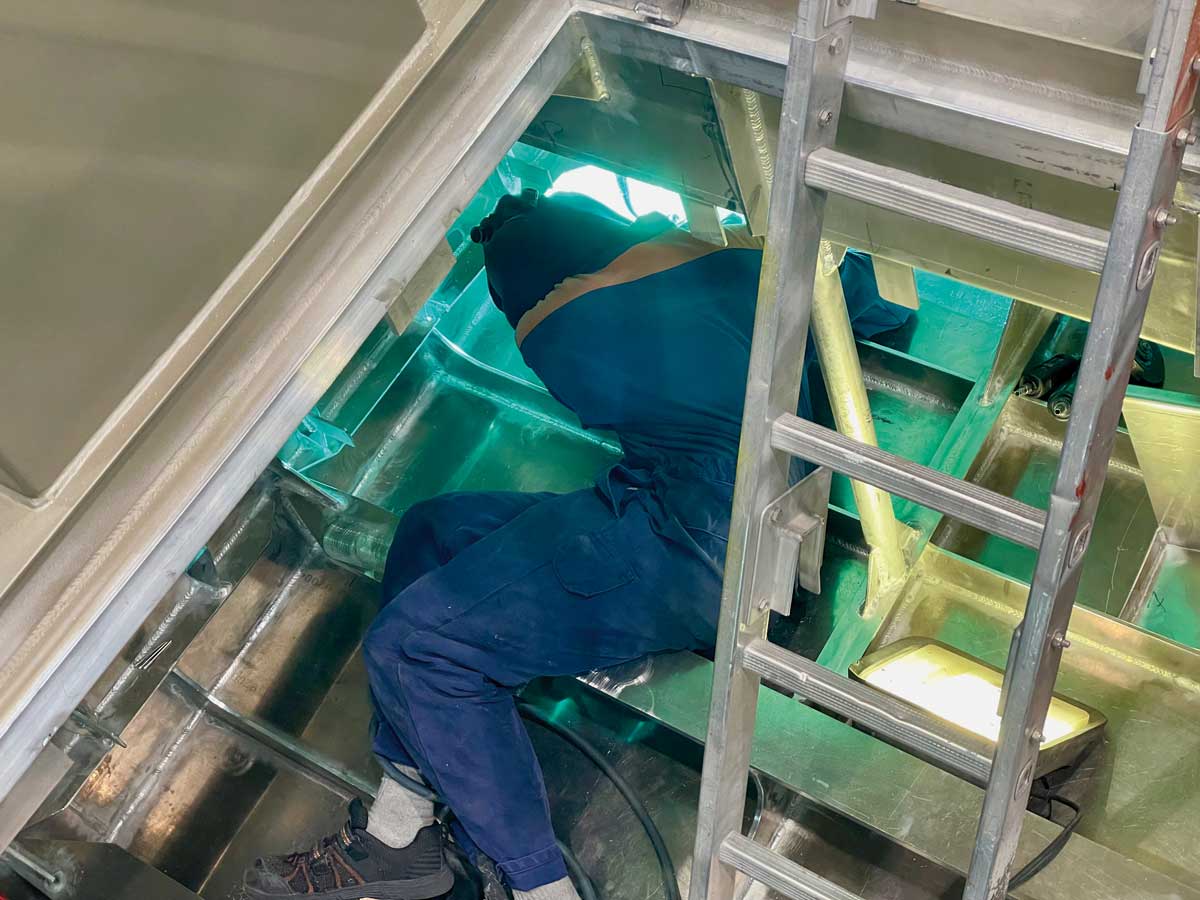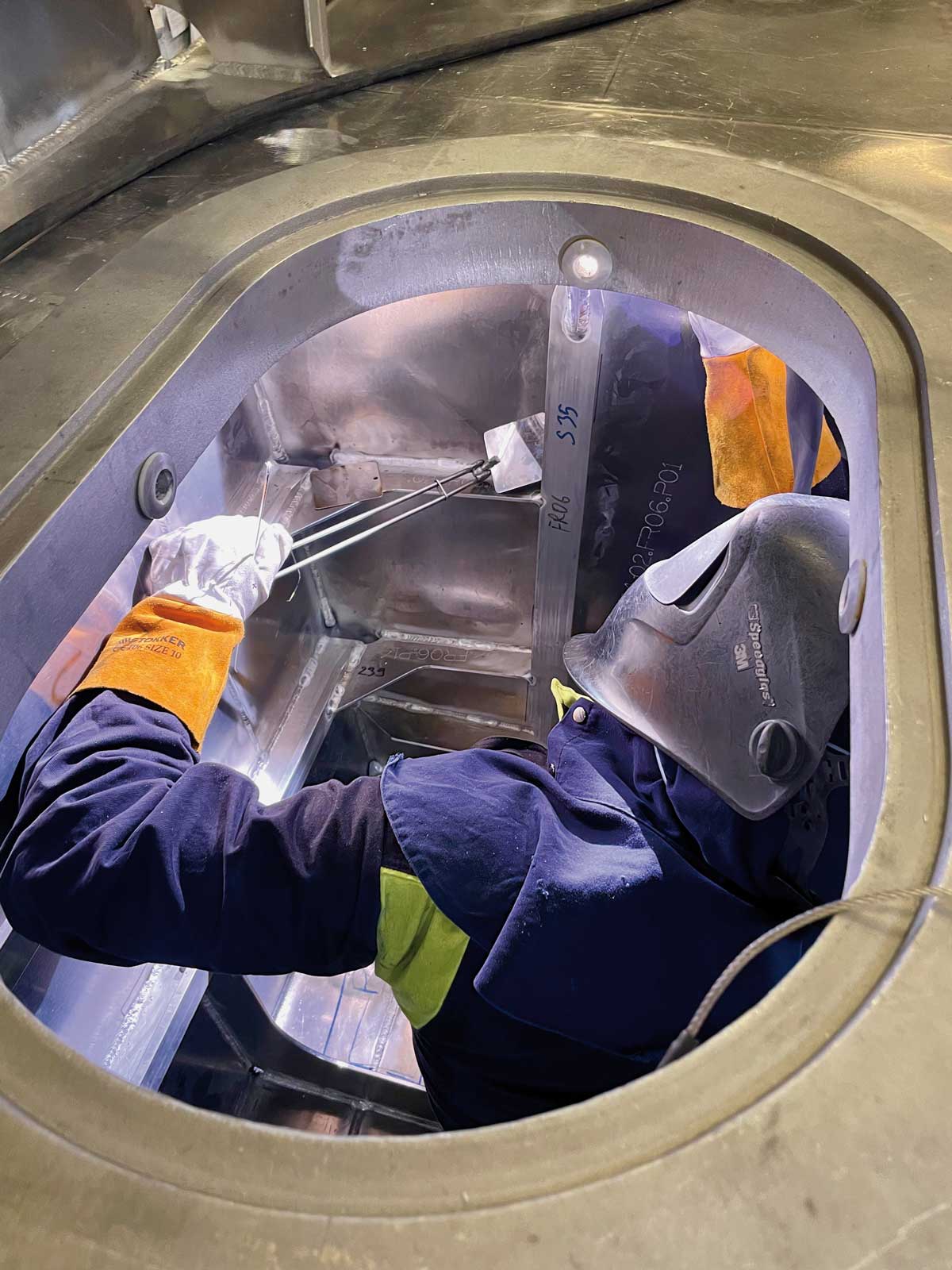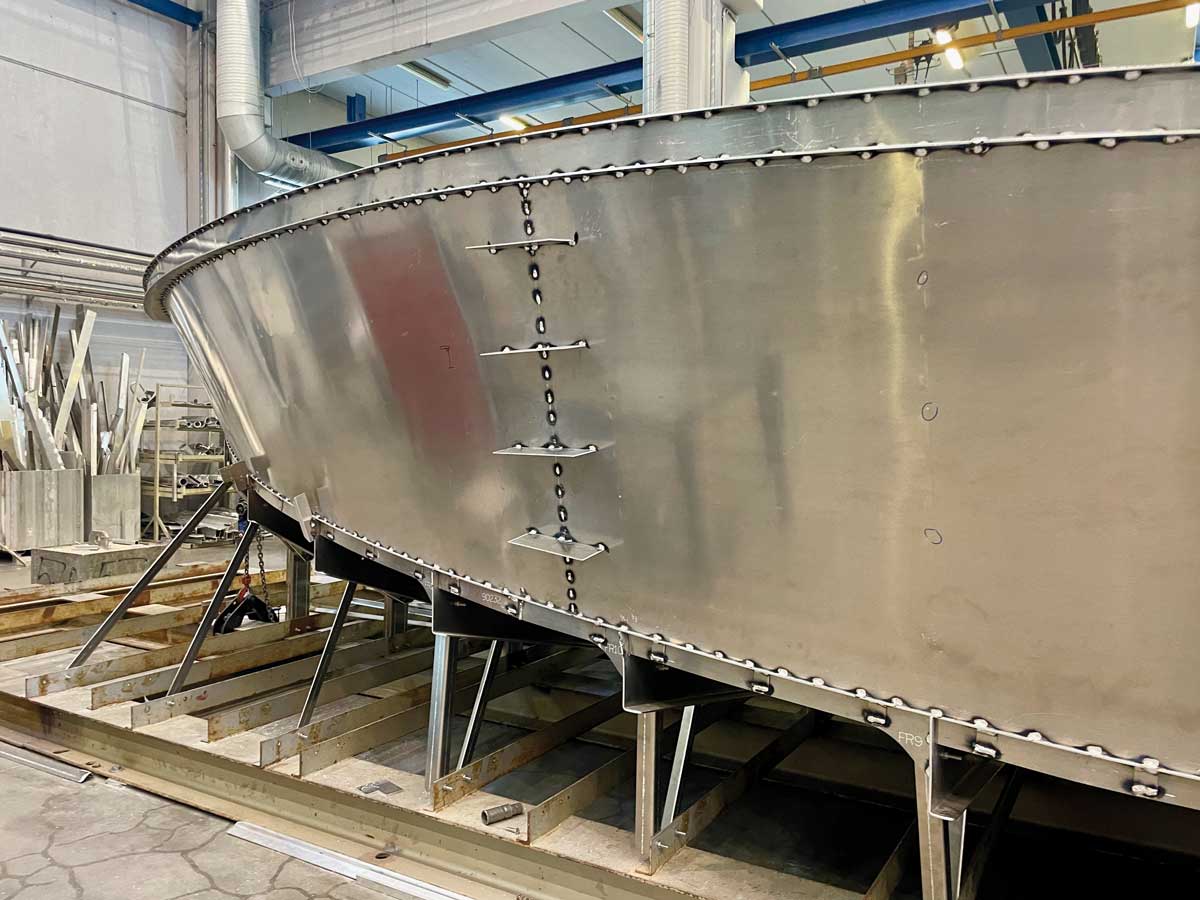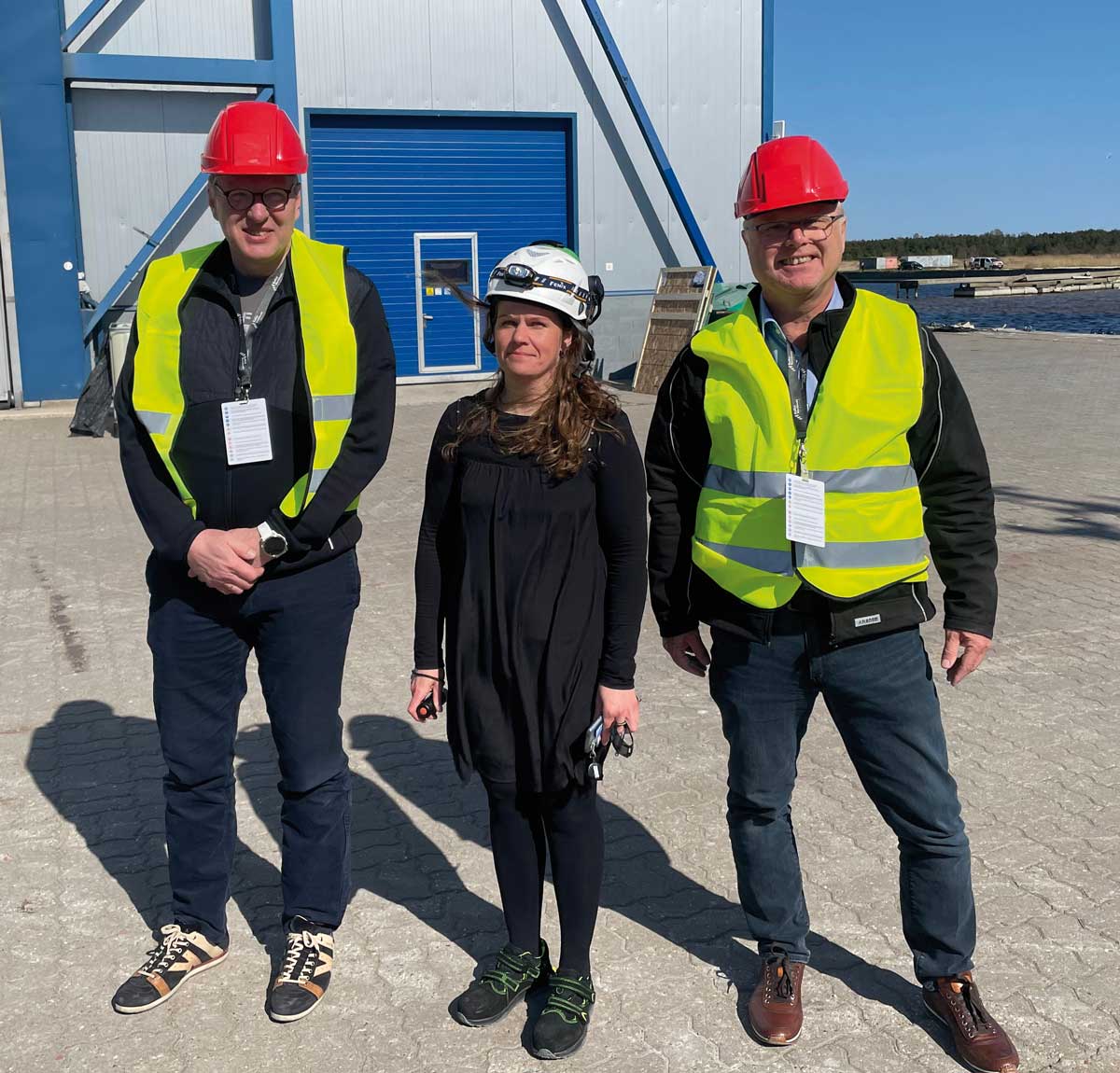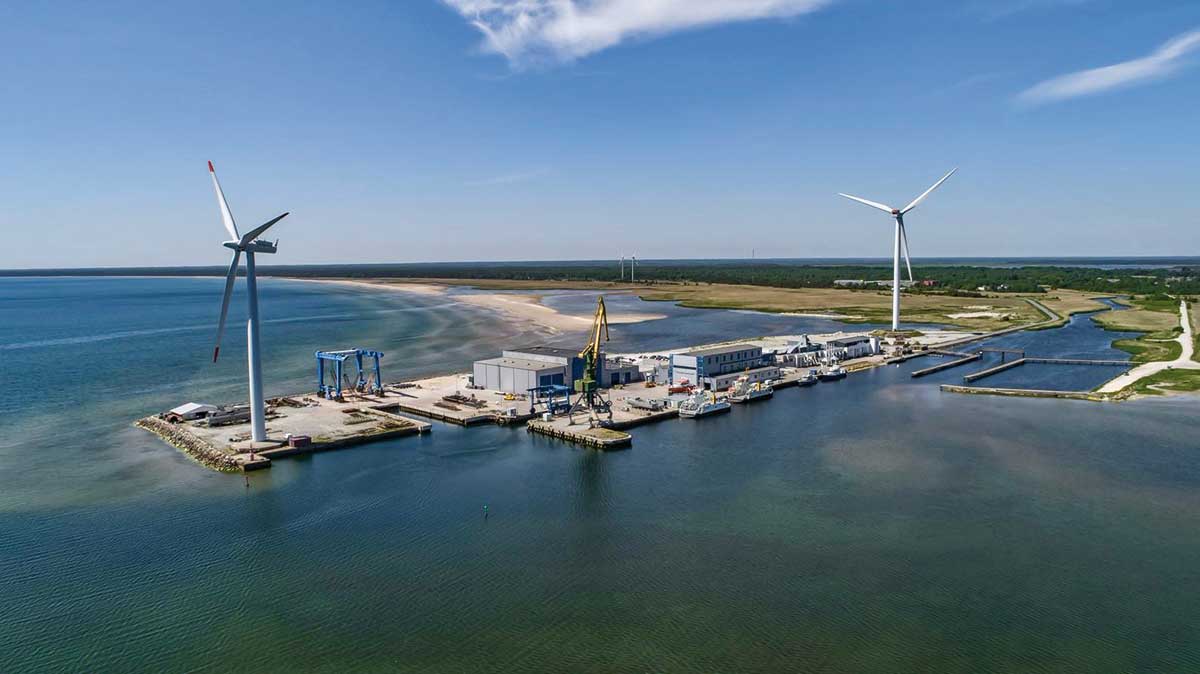Innovation, sustainability and zero-defect production in a Baltic shipyard.
The Estonian company produces boats up to 100 m long, mainly made of aluminium, in a patented design. Despite unfavourable climatic conditions, excellent weld seam quality is achieved by adhering to the necessary framework conditions. At the same time, even a surplus of electrical energy is produced.
Baltic Workboats (BWB) is an Estonian company specializing in the production of workboats, patrol boats, ferries, catamarans and other specialized vessels. The company was founded in 1998 and is headquartered on the island of Saaremaa in Estonia. 200 employees have already been able to deliver more than 200 boats for customers in 30 countries worldwide with lengths of up to 100. In addition to conventional diesel engines, hybrid drives (diesel/electric) and also purely electrically powered boats are already being manufactured.
The company has established a strong presence in the European market in recent years and supplies customers in many countries around the world.
Of particular note is Baltic Workboats patented wave piercing bow technology. This is an innovative hull design for vessels that offers improved stability and seaworthiness at high speeds.
The concept of wavepiercing technology is that the bow of the hull is cut in the shape of a V-shaped profile that dips into the water at shallow angles, cutting through the water instead of dispersing it. This creates less drag and allows the vessel to sail faster. Wavepiercing technology is particularly effective at high speeds and in rough sea conditions.
Baltic Workboats' patented wave piercing technology is an evolution of the original concept. The difference is that the bow tip is designed in the form of a double V-profile, which combines the advantages of a normal wavepiercing hull with added stability and load-bearing capacity. This allows the vessels to operate in extreme sea state conditions and achieve improved performance.
Another benefit of Baltic Workboats' wave piercing technology is that it reduces the vessel's fuel consumption. By reducing drag, the vessel can operate on less fuel at the same speed, resulting in significant savings in operating costs.
Baltic Workboats has made a name for itself as an innovative company that manufactures high-quality products. The company uses state-of-the-art technology to meet the needs of its customers and is known for being responsive to individual customer requirements.
Saaremaa is the largest island in Estonia and is located in the Baltic Sea. The island has a temperate climate influenced by its close proximity to the sea and the North Atlantic Ocean. The climate on Saaremaa is generally mild and humid, with mild summers and cold winters.
In summer, temperatures on Saaremaa usually reach highs of about 20-25 degrees Celsius and lows of about 10-15 degrees Celsius. Precipitation tends to be higher in the summer months, with an average of about 70-80 mm of precipitation per month.
In winter, the climate on Saaremaa is cold and snowy. Temperatures usually fall to around -5 to -10 degrees Celsius, but can drop below -20 degrees Celsius. Overall, the climate on Saaremaa is characterized by high humidity, which means that fog often forms. The island is also affected by strong winds, especially in autumn and winter when storms blow in from the North Atlantic.
For arc welding of aluminum, these are conceivably unfavorable climatic conditions.
Nevertheless, BWB has managed to achieve excellent weld quality by following a few essential rules.
Baltic Workboats builds its boats mainly from aluminum, a light and strong material that is ideal for boat building. Much lighter than steel, the boats have much lower fuel consumption and longer life. The material of the sheets is naturally hard EN AW 5083 H111 (AlMg4,5Mn) in the thickness range from 4 to 40 mm. Profiles are made of the hardenable material EN AW 6082 T6 (AlSi1MgMn).
The plates are cut by CNC milling with carbide tools dry, i.e. without lubricants, which is an excellent precondition for welding. In the same step, the blanks are marked and labeled so that they can later be placed on the correct sections.
Another important aspect of production at Baltic Workboats is the careful temperature control in the production halls. The halls are kept at a constant temperature of 22 degrees Celsius, which is achieved with an environmentally friendly wood chip heating system. No welding is allowed while the doors are open, and this is one of BWB's basic rules.
The base materials are also stored in the heated hall at constant temperature. This temperature control is crucial for the quality of the welds, as it ensures that condensation does not occur, resulting in optimum weld quality.
Condensation is a physical phenomenon in which a gas or vapor changes to a liquid state. This occurs when a gas is cooled, causing the molecules of the gas to lose their kinetic energy and move more slowly. When the speed of motion of the molecules is below a certain threshold, they begin to condense and form liquid droplets.
Condensation can occur on cold surfaces which are brought into warm air. When welding aluminum, condensation and thus moisture originating from the ambient air can cause significant problems.
Moisture contains hydrogen and this is the only gas soluble in aluminum. Liquid aluminum has very good solubility for hydrogen. However, upon cooling, a solubility jump occurs near the solidification temperature. The hydrogen coming out of solution leads to gas bubbles, which are trapped in the solidifying material and then lead to so-called pores. Therefore, when welding aluminum, the best possible cleanliness and absence of moisture are crucial for pore-free welds.
A constant ambient temperature such as BWB excludes condensation from the outset and is the prerequisite for pore-free welds. In fact, surfaces on which condensation has once occurred cannot be "repaired" by simple drying. A new surface cleaning by machining would be necessary.
The welding processes used at BWB are MIG pulse and TIG welding.
Inside the boats, accessibility is often very limited due to tight spaces.
Welders appreciate the constant, comfortable ambient temperature, which does not require additional clothing beyond the protective clothing required for welding and which would restrict mobility.
The same rules that apply to the storage of basic materials, also apply to the welding consumables. The vacuum packaging of the welding wire spools in a multilayer aluminum composite foil is advantageous. This foil is diffusion-tight and ensures that no condensation can occur even during temperature fluctuations during transport or storage. The vacuum also allows the packaging to be checked to ensure that it is intact. The welding wire manufacturer, MIGAL.CO, itself carries out regular welding tests with subsequent radiography in order to prove the X-ray-safe processing. The vacuum packaging ensures that the quality of the products also reaches the user.
The responsible welding engineer, Riina Otsason, is convinced that it is only the consistent observance of these measures that is responsible for the almost zero-defect production over many years.
The central inert gas supply is provided by stainless steel piping. But in same areas also gases in cylinders are used Only high-quality gas hoses are used from the tapping point. With otherwise often used, low-cost hoses made of e.g. PVC, considerable diffusion of moisture through the otherwise dense material can occur due to the partial pressure. Diffusion is the process by which particles move from a location of higher concentration to a location of lower concentration due to their thermal energy.
When a plastic surface is exposed to a humid environment, a partial pressure gradient is created. The moisture has a higher partial pressure than the dry gas inside the hose. As the moisture migrates in the direction that the partial pressure decreases, it will diffuse through the plastic.
This process depends on several factors, including the type of plastic, the thickness of the material, the ambient moisture concentration, and the temperature. Some plastics, such as polyethylene, are relatively impermeable to moisture and therefore have a lower diffusion rate than other plastics such as PVC, nylon or polyester.
BWB uses pure argon as shielding gas for sheet thicknesses below approx. 10 mm; argon/helium mixtures are used for thicker sheets and more crucial joints or locations.
To avoid welding distortion, the structures are held in shape by a large number of tack welds. These tack welds are removed again shortly before the actual welding to produce flawless welds throughout.
Defect-free welds are rewarded. Welders receive quality-related bonuses.
The required weld seam quality is influenced by the respective project requirements and by the class societies. In areas below the waterline, assessment group B (EN ISO 10042) is required, above this, assessment group C is also sufficient. All welds are subjected to 100% visual inspection, critical areas are subjected to PT inspection and further volumes are radiographed depending on the requirements. The defect rate below the waterline is actually very near zero.
Visitors to BWB are struck by the cleanliness, unusual for a shipyard, with a large number of vacuum cleaners everywhere. The air quality in the production halls is excellent and is achieved by an effective ventilation and extraction system.
However, Baltic Workboats' commitment to sustainability goes far beyond heating the production halls from renewable sources. The company has installed two wind turbines on its premises that generate enough electricity for the plant and neighboring homes. This measure not only meets Baltic Workboats' electricity needs, but also reduces its environmental impact. The company also uses recycling methods to reduce waste and conserve resources.
Baltic Workboats is an example of how a company can succeed in the shipbuilding industry by balancing innovation and sustainability.
A key challenge for BWB and Riina Otsason is the availability of qualified aluminum welders. However, the company also sees its exposed location as an advantage.
In fact, Saaremaa offers a variety of advantages for workers, especially for those seeking a quiet and natural environment. Of particular note is a high quality of life: Saaremaa is an idyllic island in the Baltic Sea, known for its stunning scenery, clean air and clear waters. The island is a quiet and relaxing place, ideal for people looking for a retreat from urban life. Compared to many other cities and regions in Europe, the cost of living in Saaremaa is relatively low. Rents, food and other expenses are cheaper here than in many other areas, which allows workers to live a comfortable life without overextending themselves financially. Despite its rural location, Saaremaa offers a modern infrastructure with well-developed roads, airport and ports that allow workers to travel quickly and easily. The island also has good connections to the mainland via ferry service. Saaremaa has a well-developed educational infrastructure with schools, vocational schools and a university, which will offer a master's degree in marine engineering from the fall of 2023. The people of Saaremaa are close to nature and place great importance on protecting their natural environment. The island offers an abundance of outdoor activities such as hiking, cycling, fishing and boating, which are appreciated by many workers as a balance to their daily work routine.
Overall, Saaremaa offers a high quality of life, good job opportunities and a natural environment that can be attractive to many workers.






